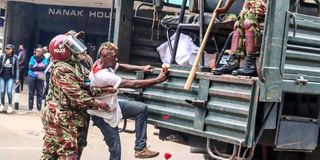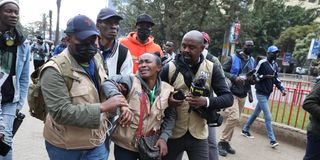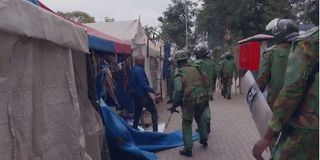Premium
Nane Nane: Peaceful demos disrupted by violent police in Nairobi, youths in Coast and Western keep off streets

Police officers arrest a protester during Nane Nane protests along Kimathi Street in Nairobi on August 8, 2024.
What you need to know:
- All roads leading to State House— Arboretum, Dennis Pitt, State House, Jakaya Kikwete and Processional— were barricaded by heavily armed police, with truckloads and busloads of riot police on standby in Nairobi Area.
- Most businesses remained closed for a good part of the day. Even the bodaboda riders on the streets were few, in sharp contrast to what was witnessed in the previous anti-government demonstrations some two weeks ago.
Tension remained high in Nairobi and other major towns across Kenya amid peaceful demonstrations by youth pushing for sweeping governance and economic reforms.
In the capital, police, who mounted roadblocks on major roads leading into the city, on Thursday arrested scores of Nane Nane protesters and would-be protesters as they attempted to assemble on Moi Avenue, Kenyatta Avenue, Kimathi Street, Mama Ngina Street, Uhuru Highway and other roads.
They were arrested by plainclothes officers before being bundled into police lorries that were stationed at strategic locations. Their fate was not immediately clear.

Police officers arrest a demonstrator along Tom Mboya Street in Nairobi County on August 8, 2024 during the antigovernment demonstrations.
This came as police fired tear gas at protesters to prevent the demonstrators from accessing the central business district.
The Dedan Kimathi monument, named after the freedom fighter, on Kimathi Street, was the epicentre of the action.
The police, at some point, turned against the battery of local and international journalists covering the demos, with Cecilia Ngunjiri sustaining injuries.

Cecilia Ngunjiri, a journalist who was attacked by police.
Earlier in the day, armed police had mounted roadblocks on major roads leading into the city, with matatus mostly being flagged down for inspection to isolate protesters.
Similar deployments were witnessed around protected areas and major government installations, including Jomo Kenyatta International Airport, State House, Parliament, Harambee House, Central Bank of Kenya and Times Tower.

Police chase away traders from the Nairobi CBD on August 8, 2024.
Along Thika Road, one of the police checks was near Vincentian Retreat Centre, just after the entry into the highway from Thika town, and another after Safari Park for Nairobi-bound traffic.
Along Jogoo road, another police check was mounted near city stadium.
All roads leading to State House— Arboretum, Dennis Pitt, State House, Jakaya Kikwete and Processional— were barricaded by heavily armed police, with truckloads and busloads of riot police on standby in Nairobi Area.
Most businesses remained closed for a good part of the day. Even the bodaboda riders on the streets were few, in sharp contrast to what was witnessed in the previous anti-government demonstrations some two weeks ago.
From 2pm, police changed strategy and started clearing the city centre— ordering matatus and boda bodas to leave as traders were instructed to closes their businesses.
Seven protestors arrested
Some of the traders who were caught unawares faced the wrath of the officers, who spared no one, with more arrests being made.
Outside the capital, there was heavy police deployment across Kenya’s other cities— Mombasa, Nakuru and Kisumu— with officers patrolling the streets.
In Kitengela, Kajiado County, at least seven protestors were arrested on Deliverance Road as they attempted to light a bonfire.
With a roadblock mounted on the Namanga highway, a contingent of GSU officers patrolled the town, as a helicopter hovered over the town, and foiled plans by youths to stage a protest by 1pm.
Most of the police vehicles had their number plates covered with tape.
Despite Governor Joseph Ole Lenku and County Commissioner James Taari urging traders to open their businesses, most of them opted to close shop.
"The fear of looting is real. I had to close my business in the fear of any eventuality. Kitengela has become a hotbed of anti-government protests," said James Mwangi, a trader.
By 1pm, the town remained deserted with few activities.
No demonstrators
Youth in the Coast region stayed away from the streets in Mombasa, Kilifi and Kwale, saying they were satisfied with the inclusion of Hassan Ali Joho and Salim Mvurya in the Cabinet.
In Mombasa, despite protestors staying away, police did not take any chances. They cordoned off most areas where youth converge, with different entry points to Mombasa town being sealed off.
At Makande, main entry to Mombasa from Changamwe and in Nyali, police inspected public service vehicles and interrogated any group seen accessing the town.
“We are happy with the swearing in of Mr Joho this morning, we shall use different avenues to seek for a bigger cake in the government. But with Joho we know we can have more,” said Salima Hussein, a Mombasa resident.
In Kilifi, businesses went on as usual with no demonstrators seen on the street.
In Lamu, Generation Z described the former Mombasa Governor as one of their own and that they now feel they are part and parcel of President William Ruto’s government.
Referring to themselves as the fisher folk community, the Gen Z’s reiterated that having taken charge of the Mining and Blue Economy docket, Mr Joho is well versed with the sector, expressing their expectations that he will fully revitalise it.
“We’ve decided that instead of protesting, we join hands in celebrating the swearing-in of Hassan Ali Joho as Mining, Blue Economy and Fisheries CS. He’s from the Coast. He’s also a performer. We believe his inclusion to President William Ruto’s Cabinet will give impetus to the Kenya Kwanza administration to deliver on its pledges,” said Mohamed Omar in Lamu Old Town.
Meanwhile, it was business as usual in all the streets of the major towns of Lamu. No protests were witnessed.
A spot-check by Nation established significant calm in Lamu Old Town, Shella, Mokowe, Hindi, Mpeketoni, Baharini, Hongwe, Kibaoni, Majembeni and Witu Towns.
Reports by Dan Ogetta, Millicent Mwololo, Mercy Simiyu, Sammy Kimatu, Stanley Ngotho, Kalume Kazungu, Anthony Kitimo, Kevin Cheruiyot and Ndubi Moturi.





